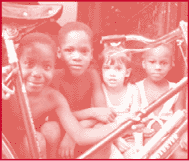 Introduction
Introduction
The HIV/AIDS epidemic is shattering children’s lives and
reversing many hard won children’s rights gains. Following
more than a decade of inadequate action, there is now an
absolute imperative that the global community and every
individual nation urgently mount large-scale, multifaceted
responses to secure the future of all orphans and vulnerable
children (OVC).
Purpose of the Paper
The paper has four main objectives:
- To present a summary of the global OVC situation and current policy responses;
- To outline existing policy frameworks for responding to OVC;
- To identify policy-level gaps in national responses to the growing crisis of OVC; and
- To propose a country-level “OVC policy package” and recommendations for future policy dialogue and action.
Focus
The paper has three explicit emphases. First, a recognition
that the overwhelming majority of OVC live in developing
countries, in particular in sub-Saharan Africa, and this is
therefore the focus of the paper and the source of most of
the examples that are cited. Second, an emphasis on HIV/
AIDS affected children (as opposed to infected children),
while recognizing that many OVC may be both affected and
infected. And finally, a focus on the policy level, as opposed
to the program or intervention level, though this distinction
is somewhat artificial and at times difficult to make.
This final focus means that the paper does not attempt to
present any of the implementation and service provision
challenges that are currently in the public debate, such as
how to scale up responses and roll out successful pilot
projects. In addition, the brief does not permit a
comprehensive exploration of specific issues that have clear
policy implications such as the dilemma of community-based
versus institutional care; the importance of including
psychosocial support for OVC as part of comprehensive and
holistic support; the critical need to vigorously address child
sexual abuse; and the challenge of keeping infected parents
alive to reduce or delay orphanhood. These issues are
adequately covered in other publications, as well as within
national and international forums.
|
“The children of the world are innocent, vulnerable,
and dependent. They are also curious, active, and full
of hope. Their time should be one of joy and peace, of
playing, learning, and growing. Their future should
be shaped in harmony and co-operation. Their lives
should mature, as they broaden their perspectives and
gain new experiences.”
World Declaration on the Survival,
Protection, and Development of Children
September 30, 1990
|
Target Readership
This paper is written primarily for individuals with strategic
decision-making responsibilities for HIV/AIDS programs,
in general, and for OVC programs, specifically—including
USAID personnel (such as health and population officers in
missions), other donors, and program managers in
government and in civil society structures (such as
nongovernmental organizations [NGOs] and faith-based
organizations [FBOs]).
Methodology
Three main methodologies were used in preparing this paper:
a literature review; an analysis of information provided by
POLICY Project offices in Benin, Cambodia, Haiti, Kenya,
Nigeria, Uganda, and Zambia; and papers presented and
dialogue with participants at the Eastern and Southern Africa
Workshop on Orphans and Vulnerable Children held in
Windhoek, Namibia, in November 2002.
The country-level information from POLICY Project staff
was provided in response to a questionnaire. The
questionnaire covered the legal and policy environment
within countries related to both children and HIV/AIDS,
OVC definitions used in policies, the forms of state support
(if any) available for children, and whether or not an OVC
assessment had been done and if the results had been used
in defining appropriate responses. Except for a couple of
instances, most of the information provided in the
questionnaires concurred with other sources of information.
|






